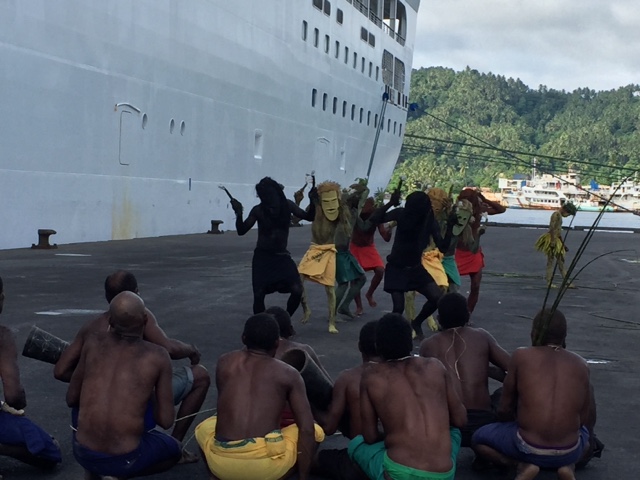We spent the morning visiting the various reminders of this tragic time. Our van once again travelled over bumpy roads, often weaving from one side to another. The dirt from the road often covered the roads and trees. Our first stop was the Japanese Barge Tunnel. The tunnel was built into a mountainside to hide barges from the Allied air attacks. Three rusting barges remained inside the tunnel. We also passed a rusting crane that was used to load the barges.
We then travelled to Kokopo, the capital city. We past grocery stores, hardware shops, and other markets. People often lined the roads, waving to us as we passed. Ships only arrive about once a month so it brings lots of excitement to the town. Kids smiled with excitement each time we waved back to them. We spent about 20 minutes at the Kokopo Local Market. So many people were selling peanuts and other fresh vegatables. We also entered a building where fish were being sold. The last building contained merchandise that people had made...bracelets, baskets.......and beautiful cotton fabric that the women had made. It didn't take us long for Rose and me to find fabric. It was the best find of the cruise.
Next we headed to the Kokopo War Relics and Museum. Old tanks, guns, engines pulled out of the bay. Bombs, motorcycles, a plane were displayed. It was very interesting to see these WWII relics.
We also visited Admiral Yamamoto's bunker #1. This was the place he was planning to direct the invasion of Australia. The bunker had many narrow steps and low ceilings. Writings and maps could be seen on the walls. It was extremely hot and very little air as John walked to the top of the inside of the bunker. There was also a historical museum in Rabaul that contained clippings from newspapers and other small objects.
As we approached the Bitapaka War Cemetery, the beauty and peaceful nature of the Cemetary reminded us of the Cemetery for those who lost their lives at the beaches of Normandy. It was much smaller but everything was landscaped and trimmed. The upkeep of the Cemetery was paid for by the Australian government. There was a section for the Australians who lost their lives; a section for Indians who were brought here to be slave labor and a section for Those killed in World War I soldiers.
Mother Nature has also had a hand in Rabaul's violent history. A cataclysmic explosion occurred 1400 years ago that formed a huge caldera into which the Pacific poured which formed the harbor of Rabaul. The 1994 eruption buried the city two meters of ash.
During the afternoon we visited the Rabaul Volcanological observatory. As we climbed to the observatory we passed many tunnels where the Japanese held their prisoners who were building the various tunnels that were needed. At the observatory John asked the person who was in charge many questions. The gentleman was really surprised that someone knew what the screens were showing. Tavurvur, one of the five volcanoes, continues to huff and puff as the regions seismic activity is measured even more conscientiously than ever.
We drove close to the base of the volcano where the Rabual Hot Springs were located. You could easily see the steam and feel the heat from the springs. We were told how the Japaneses would swim in the water where the springs flowed. The hot springs temperatures reached 78 C but the large body of water was cool enough to swim in. It was said that if you swam in these waters your life would be extended.
Our tour provided us with so much history. The people on this island were darker skinned with fuzzy hair, and very friendly. They had been isolated from Western influence, so isolated that the very first wheel ever seen was a propeller of an aircraft. We will remember the people waving and shouting "ha-lo" on the roads, in the market places, and by their homes. Our guide said they all want to come and see the strange "while people" who have come from the big white ship. These memories can't be forgotten.
That evening as we sat and had our evening hot chocolate we covered the table with all of our beautiful fabric. Each fabric brought great memories of the places we have been and the sights we have seen. But, most of all, the beauty of the simple life of the people of Papua New Guinea.










































What a history lesson! Great read.
ReplyDeleteRita
Great ending to a very nice cruise. Now enjoy the final sea days
ReplyDelete